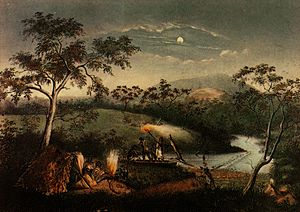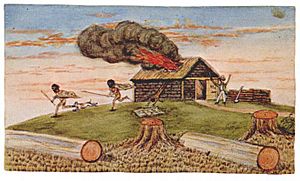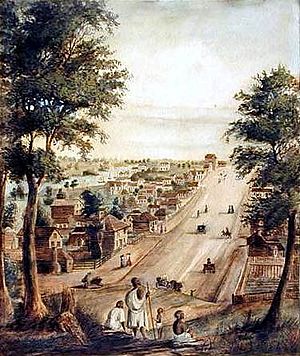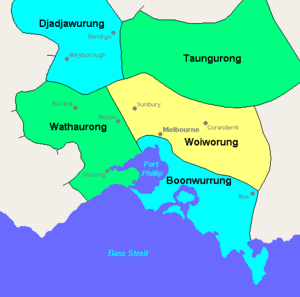Woiwurrung facts for kids
| Languages | |
|---|---|
| Woiwurrung language, English | |
| Religion | |
| Australian Aboriginal mythology | |
| Related ethnic groups | |
| Boonwurrung, Dja Dja Wurrung, Taungurung, Wathaurong see List of Indigenous Australian group names |

The Woiwurrung people are an Aboriginal Australian group. They are part of the larger Kulin alliance. Their traditional lands are in central Victoria, Australia.
The Woiwurrung people lived in an area stretching from north of the Great Dividing Range to Mount Baw Baw in the east. Their land went south to Mordialloc Creek and west to Mount Macedon, Sunbury, and Gisborne. They shared borders with other Aboriginal groups. These included the Gunai/Kurnai people to the east and the Boonwurrung people to the south. The Dja Dja Wurrung and Taungurung lived to their north.
Before European settlement, the Woiwurrung people lived off the land. They were skilled at fishing and hunting. They also gathered food like plants and roots. They even grew some plants, like murnong yams, by using controlled fires to manage grasslands. Their campsites moved with the seasons, often near the Birrarung (Yarra River) and its smaller streams. This helped them find the best food sources.
Each Woiwurrung group, called a clan, had its own area. These areas were often defined by waterways. Some of the main clans were:
- The Wurrundjeri-Willam: They lived along the Yarra River, including the area where Melbourne is now.
- The Marin-Bulluk
- The Kurung Jang Balluk
- The Wurundjeri Balluk
- The Balluk Willam
- The Gunung Willam Balluk
- The Talling Willam
Today, the term Wurundjeri is often used for all descendants of the Woiwurrung clans. This happened because they had to come together to survive after European settlement. Their special animal symbols, called totems, are Bunjil the eagle and Waang the crow.
Contents
History of the Woiwurrung People
Ancient Times in Woiwurrung Lands

People have lived in the Woiwurrung area for a very long time, possibly up to 40,000 years. They were good at fishing, hunting, and gathering food. The land around Port Phillip had many food sources, even after it became flooded about 7,000 to 10,000 years ago.
At the Keilor archaeological site, scientists found an ancient fireplace from about 31,000 years ago. This shows that people lived there very early in Australia's history. A human skull found there is also very old, between 12,000 and 14,700 years old.
During the Ice Age, about 20,000 years ago, the area now known as Port Phillip was dry land. Rivers flowed across this land. Aboriginal people could walk from southern Victoria to Tasmania across a land bridge. This bridge disappeared around 12,000 years ago as sea levels rose. Port Phillip Bay filled with water between 8,000 and 6,000 years ago.
Woiwurrung stories tell of the bay being flooded. One story says Bunjil, the creator spirit, formed the bay. Another says it flooded when the Yarra River was created.
First Meetings with Europeans

The Woiwurrung people likely knew about Europeans through their coastal neighbours, the Boonwurrung people. The Boonwurrung met French explorers in 1801 and British settlers in 1803. William Buckley, a British convict, escaped in 1803. He lived with the Wathaurong people for over 30 years. He told them about European life, which amazed them.
Seal hunters also raided Boonwurrung camps from 1809 to 1833. They often killed men and took women. This caused problems for the Woiwurrung and Boonwurrung, who were connected.
Before 1803, a smallpox disease spread among Aboriginal groups around Port Phillip. It greatly reduced their numbers. The Woiwurrung remember this as the Mindi, a rainbow serpent that brought sickness.
The Batman Treaty
On June 6, 1835, a European named John Batman met with eight Woiwurrung elders. These elders included Bebejan and Billibellary. They met near Merri Creek. They signed documents and exchanged gifts. Batman claimed to buy about 200,000 hectares of land around the Yarra River and Corio Bay. He gave them items like tomahawks, knives, and shirts. In return, the Woiwurrung gave woven baskets and two valuable Possum-skin cloaks. After signing, everyone celebrated with a traditional dance called a corroboree.
This treaty was important because it was the only time Europeans tried to negotiate for Aboriginal land. However, the British government in Sydney quickly said the treaty was not valid. They believed the land belonged to no one before British arrival. This idea was called terra nullius. It meant Aboriginal people could not sell their land.
Loss of Land and Conflicts
In October 1835, Derrimut, a Boonwurrung leader, warned early European settlers about a planned attack. The settlers prepared, and the attack was avoided. Other leaders like Benbow and Billibellary also helped protect the settlers. They saw this as part of their duty to be welcoming.
In 1840, a fight called the Battle of Yering happened. Police tried to capture Wurundjeri leader Jaga Jaga. About 50 Wurundjeri clansmen fought back, and shots were fired.
As early as 1843, Billibellary asked for land for the Wurundjeri people to live on. In 1852, the Woiwurrung were given 782 hectares along the Yarra River at Warrandyte. These areas were meant to keep Aboriginal people away from Melbourne. But these reserves were later taken back in 1862 and 1863.
Impact on Woiwurrung Society

The Woiwurrung and Boonwurrung people faced many challenges after Melbourne was founded in 1835. Their population quickly dropped. In 27 years, their numbers fell from 207 to just 28 people. Many died from diseases brought by Europeans. The birth rate also went down.
Native Police Corps
In 1842, a Native Police Corps was formed. It was hoped this would help Aboriginal men. Billibellary, a Wurundjeri elder, supported the idea at first. He even joined. But he left after a year when he saw they were used to capture other Aboriginal people. He then tried to stop others from joining.
Coranderrk Station
In 1863, the remaining Woiwurrung people were forced to move to Coranderrk Station near Healesville. They asked for this land to be given to them permanently, but it was refused. Coranderrk was closed in 1924. Most of its residents were then moved to Lake Tyers.
Woiwurrung Social Structure and Land Use
Woiwurrung communities had groups called clans. These clans owned land and spoke a similar language. They were connected by culture, shared interests, and marriage. They also traded with each other. Sometimes, access to resources like the Birrarung (Yarra River) was limited. For example, if fish supplies were low, fishing might be stopped until the fish recovered. This helped make sure resources lasted. Today, traditional clan areas are no longer used in the same way. Descendants of Woiwurrung Tribes live within modern society.
Woiwurrung Clans
Before European settlement, there were generally six separate clans:
- Wurundjeri-balluk & Wurundjeri-willam: Lived in the Yarra Valley and river area.
- Bulluk-willam: Lived south of the Yarra Valley.
- Gunnung-willam-balluk: Lived east of the Great Dividing Ranges.
- Kurung-jang-balluk: Lived from Melton to the Werribee River.
- Marin-balluk (Boi-berrit): Lived west of the Maribyrnong River.
- Kurnaje-berreing: Lived between the Maribyrnong and Yarra Rivers.
Diplomacy and Tanderrum
When people from other groups visited Woiwurrung lands, a special ceremony called Tanderrum was performed. This ceremony allowed visitors to travel safely and use the land and its resources for a short time. It was a diplomatic event where the landholders showed hospitality and exchanged gifts.
Woiwurrung Language
The Wurundjeri people were part of the Woiwurrung language group. Each clan spoke a slightly different version of the language. Here are some basic words:
- bulluk, balluk: swamp
- nira: cave
- willam, wilam, illam, yilam: hut, camp, bark
- gunung, gunnung: river
- ngamudji: red colors during sunset, white man
- The Jindyworobak Movement got its name from a Woiwurrung phrase jindi worobak, meaning to join or annex.
Woiwurrung Beliefs and Stories
The Woiwurrung people shared similar beliefs with other Kulin groups. Their beliefs are based on the Dreamtime. This is an ancient time when creator ancestors, the First Peoples, traveled the land. They created and named everything. Aboriginal traditions value the land and believe in the Dreamtime. It is both the time of creation and a present-day reality. The two main totems for the Woiwurrung people are Bunjil the Eaglehawk and Waang the Crow.
Dreamtime Stories
- Bunjil & Pallian Creation Story: Bunjil is the Creator spirit for the Kulin People.
- Birrarung Creation Story: This story explains how the Birrarung River was formed.
- Mindi: Mindi is a rainbow serpent from the northwest. It spreads disease to those who have done bad deeds. However, Mindi can only act with Bunjil's permission.
Traditional Games and Recreation
William Thomas saw Woiwurrung people playing a game called Marn Grook in 1841. This is how it was described:
- The men and boys loved to play this game.
- They made a ball from possum skin. It was bouncy but strong.
- Players did not throw the ball. They dropped it and kicked it with their foot.
- Tall players had an advantage because they could jump high to catch the ball.
- The person who caught the ball would then kick it.
- This game could go on for hours, and the players never seemed to get tired.
Marn Grook was a favorite game of the Woiwurrung clans. Teams were sometimes based on the eagle (Bunjil) and crow (Waang) totems. Some people believe this game might have influenced Australian Rules Football.
Important Places for the Woiwurrung
Many important places for the Wurundjeri people are near the Yarra and Maribyrnong Rivers and Merri Creek. These were places where corroborees were held. Clans would meet to share music, dance, news, and trade. Other important sites include:
- Kings Domain Resting Place: In 1985, the remains of 38 Victorian Aboriginal people were reburied here.
- Queen Victoria Market: This is a burial site for many Aboriginal people.
- Corner Franklin and Bowen streets: This was the site of early public executions in Melbourne.
- Jolimont: This area, including the MCG and Yarra Park, was a gathering place for Kulin groups.
- Bundoora Park: This area was used for getting bark and stone for tools.
- Bolin Bolin Billabong in Bulleen: A place for sacred and social gatherings.
- Birrarung: This was the main river in their territory. It was a major food source and meeting place.
- Warrandyte: A gorge in the Yarra River, named after actions of the Dreamtime figure "Bunjil".
- Mount William stone axe quarry near Lancefield: A place where tools were made.
- Dights Falls area: A meeting place for corroborees and a site for the Native Police Corps.
- Merri Creek: This includes the site where the treaty with John Batman was signed.
- Solomons Ford on the Maribyrnong River: A place for fish and eel traps.
- Brimbank Park, Keilor: Over 25 archaeological sites are found here.
- The Sunbury earth rings, Sunbury.
- Coranderrk Mission Station, Healesville.
- Mount Macedon axe sharpening site.
|






